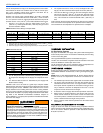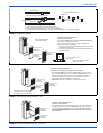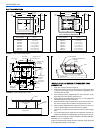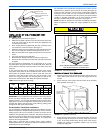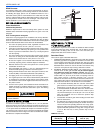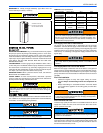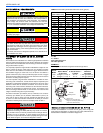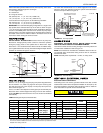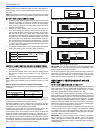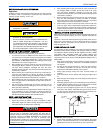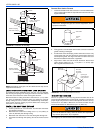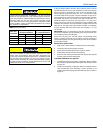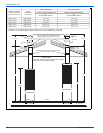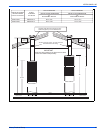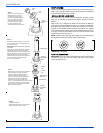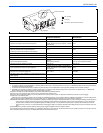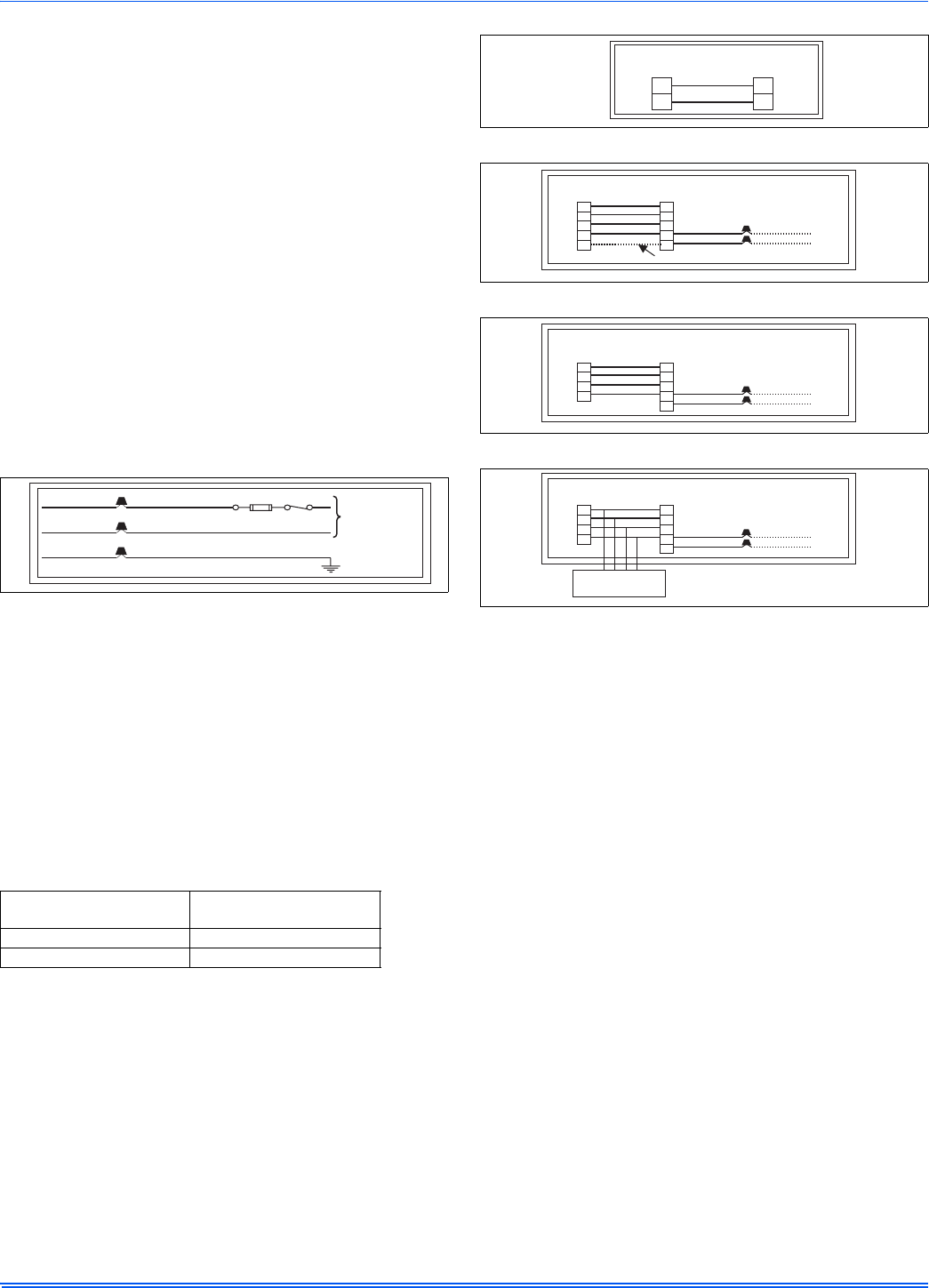
107272-UIM-B-1105
14 Unitary Products Group
NOTE: A burner with an electronic igniter or a PSC motor will have a
lower operating current. The actual load should be determined by a cur-
rent meter.
NOTE: See appliance manufacturer’s burner specifications for required
outlet pressure. Pressure is 100 psig (689 kPa) unless otherwise noted.
SUPPLY VOLTAGE CONNECTIONS
1. Provide a power supply separate from all other circuits. Install
overcurrent protection and disconnect switch per local/national
electrical codes. With the control box switch in the OFF position,
check all wiring against the unit wiring label. Refer to the wiring
diagram in this instruction.
2. Remove the screws retaining the wiring box cover. Route the
power wiring through the opening in the unit into the junction box
with a conduit connector or other proper connection. In the junction
box there will be two wires, a Black Wire, a White Wire and a
Green Screw. Connect the power supply as shown on the unit-wir-
ing label on the coil compartment panel on the DFAA or the onside
of the burner door on the DFAH or the wiring schematic in this sec-
tion. The black furnace lead must be connected to the L1 (hot) wire
from the power supply. The white furnace lead must be connected
to neutral. Connect the green furnace lead (equipment ground) to
the power supply ground screw.
3. The furnace's control system requires correct polarity of the power
supply and a proper ground connection. Refer to Figure 20.
LOW VOLTAGE CONTROL WIRING CONNECTIONS
1. Insert 24 volt wires through the small plastic bushing just above
the control panel.
2. Connect the thermostat wires to the furnace low voltage pigtails.
See Figure 21 (heating only) and Figure 22 or 23 (heating and
cooling).
3. Connect low-voltage circuit to the wall thermostat pigtails.
NOTE: Five-conductor thermostat cable is recommended for all instal-
lations to allow easy installation of an air conditioning system at a later
time.
Eighteen gauge thermostat wire is highly recommended.
Smaller gauge thermostat wire may be used only if the guideline below
is followed.
Do not use the thermostat wire smaller than 22 gauge. If thermostat
wire small than 18 gauge is used, pay particular attention that the con-
nections between the difference wire sizes are tight.
Operational problems may be caused by loose connections or by the
use of thermostat wire that is too small to carry the required load. Any
such problems are the responsibility of the installer.
A separate 115 V.A.C. supply circuit must be used for the furnace. The
circuit should be protected by a 15 amp fuse or circuit breaker.
Avoid locations where the thermostat could be subject to drafts from
outside, or exposed to direct light from lamps, sun, fireplaces, etc., or
affected by air from a duct register blowing directly on the thermostat.
The wall thermostat should be located 52 to 66 inches above the floor.
The preferred location is on an inside wall situated in an area with good
air circulation, and where the temperature will be reasonably represen-
tative of other living areas the thermostat is controlling.
IMPORTANT: Some electronic thermostats do not have adjustable heat
anticipators. They may have other type cycle rate adjustments. Follow
the thermostat manufacturer's instructions.
The 24-volt transformer is part of the Electronic Oil Primary Control.The
transformer may not be used to provide 24-Volt power for an air condi-
tioning unit contactor. DFAA has a separate 24-Volt transformer that
maybe used to provide 24-volt power for air conditioning contactor.
SECTION VI: VENT/COMBUSTION AIR
SYSTEM
VENT AND COMBUSTION AIR SAFETY
This furnace is designed for Manufactured (Mobile) Home and Modular
Home application. It may be installed without modification in an equip-
ment room, alcove, or any other indoor location where all required
clearance to combustibles and other restrictions are met.
The venting system must be installed in accordance with UL311 Stan-
dard For Safety for Roof Jacks for Manufactured (Mobile) Homes and
Recreational Vehicles, NFAA 501C and in the Federal Manufactured
Home Construction and Safety Standings, or CAN/CSA - B139-00
Installation Code for 0il Burning Equipment (latest edition), or applicable
provisions of the local building code and these instructions. The furnace
shall not be connected to any chimney, a flue serving a separate appli-
ance, or any appliance designed to burn solid fuel.
It is recommended that the appliance is installed in a location where the
space temperature is 32 °F (0°C) or higher. If the appliance is installed
in a location where the ambient temperature is below 32 °F (0°C), the
combustion by-products could condense causing damage to the appli-
ance heat exchanger and/or the Roof Jack.
IMPORTANT: The “VENT SYSTEM” must be installed as specified in
these instructions for Manufactured (Mobile) Home and Modular
Homes. This appliance must be vented with an approved manufacturer
supplied roof jack. May not be common vented with another gas-fired or
oil-fired appliance.
FIGURE 20: Line Wiring Connections
Thermostat Wire Length
(Furnace to Thermostat)
Thermostat Wire Gauge
0 - 45 feet 22
0 - 70 feet 18
BLK
WHT
GRN
BLK (Hot)
WHT (Neutral)
GRN
Nominal
120 Volt
FIGURE 21: Wiring for Heat Only Thermostat
FIGURE 22: Wiring for Electronic Heat-Cool Thermostat
FIGURE 23: Wiring for Standard Heat-Cool Thermostat
FIGURE 24: Wiring for Blend Air Accessory
Room
Thermostat
Furnace
Control
R
W
R
W
Room
Thermostat
Furnace
Control
Condensing
Unit
ToAir Conditioner
Controls
R
W
G
Y
C
R
G
C
Common T’stat Connection
W
Y
Room
Thermostat
Furnace
Pigtails
Condensing
Unit
ToAir Conditioner
Controls
R
W
G
Y
R
G
C
W
Y
Room
Thermostat
Furnace
Pigtails
Condensing
Unit
ToAir Conditioner
Controls
R
W
G
Y
R
G
C
W
Y
BlendAir
Control Box



